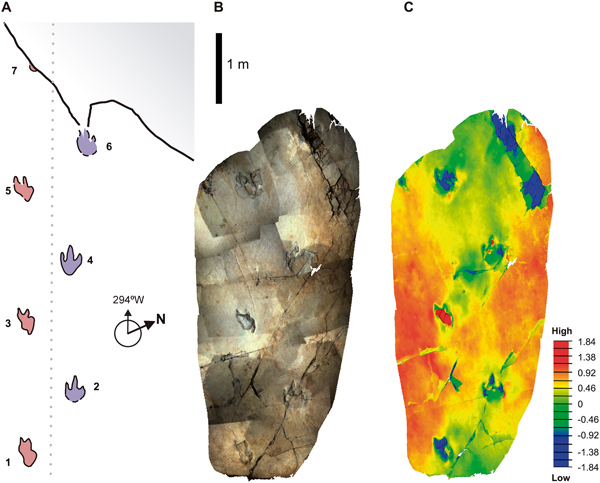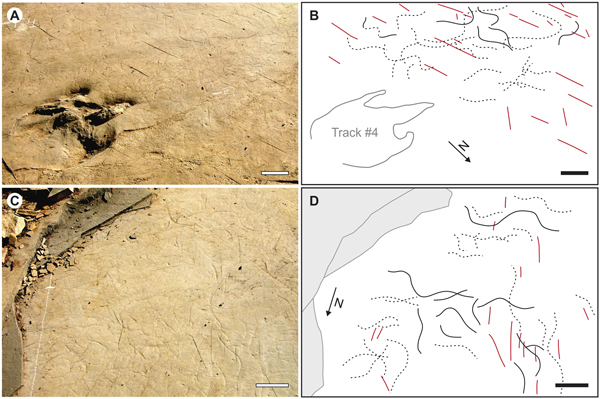A Large Theropod Trackway from Spain
Scientists have identified a trackway made by a large theropod dinosaur as it crossed shallow water, the tracks are exceptionally wide and reveal that this unfortunate predator probably had a dislocated toe.
Writing in the open access journal PLOS One, the researchers describe an exceptionally wide trackway (LH-Mg-10-16), made by a meat-eating dinosaur at a site at the Las Hoyas locality (La Huérguina Formation), in central Spain. The trackway consists of six prints (three left and three right prints) and has been interpreted as representing a large theropod dinosaur crossing shallow water, blanketed by a microbial mat.

Lower Cretaceous (Barremian Faunal Stage)
The famous Las Hoyas site has been dated to around 129-127 million years ago (Barremian faunal stage of the Early Cretaceous). Although the Las Hoyas locality has yielded many amazing vertebrate fossils (birds, amphibians, fish), dinosaur fossils are relatively rare. Stride length calculations indicate that the theropod that produced this trackway had a hip height of around two metres. This would suggest a total body length of approximately eight metres. As far as Everything Dinosaur team members are aware, the only large theropod described from fossils associated with Las Hoyas is Concavenator (C. corcovatus).
It is not possible to determine the genus from these tracks, although the prints indicate a theropod that was either bigger than Concavenator or an exceptionally large Concavenator specimen. The known foot bones of Concavenator would have created a print, approximately half the size of the LH-Mg-10-16 tracks. This suggests that there may have been a much larger, as yet undescribed, theropod present in the Las Hoyas ecosystem.

The picture (above) shows a Wild Safari Prehistoric World dinosaur model.
To view this model range: Wild Safari Prehistoric World Models and Figures.
Theropod Dinosaur Crossing Water
Sedimentary analysis indicate that the trackway was produced as the dinosaur traversed a microbial mat located on the bed of a watercourse. Marks on the surface of the substrate have been diagnosed as swimming traces of fish. The ichnospecies Undichna unisulca has been proposed, an ichnotaxon associated with the Las Hoyas site. The research team postulate that the trails were made by a type of deep-bodied bony fish (pycnodontiform), although body fossils of these fish are not common at Las Hoyas.

A Damaged Left Foot
Detailed analysis of the trackway suggests that the “wide-steps” of the theropod are not unusual compared to other bipedal dinosaur tracks, but they do confirm that these trace fossils were made by a single individual animal.
The right footprints are more regular in shape compared to those made by the left foot. On the left foot the limited impressions made by digit II suggest that either this toe is missing or it is dislocated in some way. Birds suffer from “crooked toes”, a condition caused due to environmental factors, dietary deficits or genetics. In theropod dinosaurs it is often digit II that shows pathology including damage to the bones.

Evidence of a Deformity or Injury
The research team concludes that despite a suspected toe injury/deformity the tracks reveal no signs of a limp. These remarkable trace fossils have captured a moment in time during the Early Cretaceous when a large, meat-eating dinosaur with a body length in excess of eight metres crossed a pool of water that was teaming with fish.
The scientific paper: “A theropod trackway providing evidence of a pathological foot from the exceptional locality of Las Hoyas (upper Barremian, Serranía de Cuenca, Spain)” by Carlos M. Herrera-Castillo, José J. Moratalla, Zain Belaústegui, Jesús Marugán-Lobón, Hugo Martín-Abad, Sergio M. Nebreda, Ana I. López-Archilla and Angela D. Buscalioni published in PLOS One.
Visit Everything Dinosaur’s award-winning website: Everything Dinosaur.

